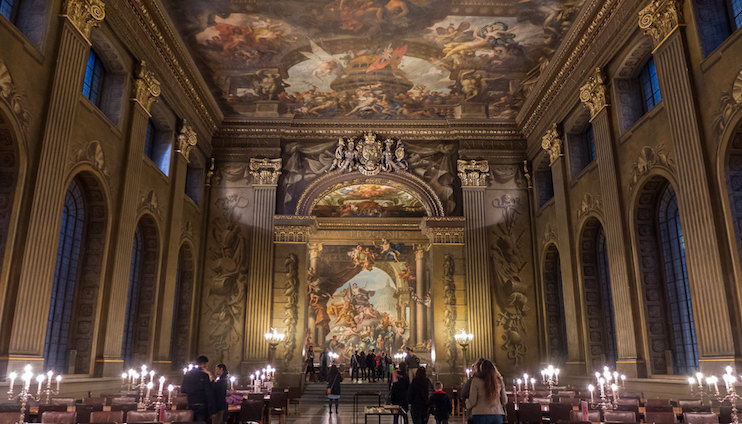London’s Best Kept Secrets: Painted Ceilings
The Vatican is not the only city with an impressive painted ceiling. London has at least two, thanks to Thornhill and Rubens.

Thornhill and Rubens gave London two of its most extraordinary ceilings, both open to the public. Though either ceiling may lay claim to the title of London’s Sistine Chapel, another Italian predecessor is well worth a look, no airline ticket required.
The world has one very famous painted ceiling that eclipses all others, and it’s not in London. While the Sistine Chapel is a holy space and the site of the papal conclave, two of the most ornately decorated ceilings in London were designed to look over grand dining tables. The Painted Hall in the Old Royal Naval College in Greenwich was intended as a dining room for naval veterans. Sir James Thornhill took 19 years (1708-27) to decorate the Hall, including its elaborately figured domed ceiling. By the time it was ready for those veterans who were still around, it was decided that the paintings were too impressive to grace the masticatory habits of old sea dogs, so the Hall was opened to the public instead, and the venerable pensioners dined in the rooms below.
Michelangelo may be the most famous person to ever paint a ceiling, but Rubens is hardly an unknown, and he is responsible for the canvases adorning the ceiling of the Banqueting House in Whitehall, painted and installed in 1636. The Tate have some of his preliminary sketches in their vaults, but the finished work is available to view by the general public (for a modest fee) and by guests of various awards ceremonies (with a goody bag thrown in). Rubens never got to see the paintings in situ, or the kerfuffle caused by a clerical error to do with the measurements - apparently Belgian feet were at the time bigger than English feet. It is claimed however that the ceiling was one of the last things Charles I looked upon before his beheading. Whether or not the monarch’s life flashed before his eyes at the point of death, Rubens provided a highly symbolic and beautifully rendered version of the achievements of his father, James I to take Charles to his headless rest.
So which of these impressive ceilings can be rightfully described as London’s Sistine Chapel? Both are situated in buildings created by two of the biggest names in the history of architecture. Sir Christopher Wren designed the Painted Hall in collaboration with Nicholas Hawksmoor, while Inigo Jones’ Banqueting Hall is one of the architect’s most notable accomplishments. Thornhill also contributed paintings to the dome of St Paul’s Cathedral, depicting the life of the saint. His ceiling in the Painted Hall is the largest figurative painting in the country, a tribute to King William and Queen Mary who take pride of place in the middle of the central oval. As befitting the building’s use, the painting is also a celebration of naval power and contains much nautical imagery.
Both the Painted Hall and the Banqueting House are highly symbolic works, but Rubens’ extravagant allegorical system somewhat outdoes Thornhill’s. One Rubens canvas is known as ‘The Peaceful Reign [or ‘The Wise Rule’] of James I’ and depicts the king as Solomon at the centre of a scene in which Peace and Plenty embrace, Minerva fights down Mars, and Mercury holds aloft two subdued snakes entwined around his caduceus (or staff) in a symbol of peace. Other scenes have titles like ‘Abundance Suppressing Avarice’ and ‘Hercules Crushing Discord’.
Rubens’ work is over 70 years older than Thornhill’s, but an even older painted ceiling is to be found on display in the Medieval and Renaissance Galleries of the V & A. The museum’s ‘Ceiling from Cremona in Italy’ dates to circa 1500, and was painted by an artist called Alessandro Pampurino. Octagonal in shape, the ceiling depicts the eight muses: Terpsichore (muse of choral dance and song), Erato (love poetry), Thalia (comedy), Melpomene (tragedy), Euterpe (lyric poetry), Clio (history), Polymnia (sacred poetry), Urania (astronomy) and Calliope (epic poetry). Fittingly for its new location, it is thought that the ceiling is taken from a room where people could meet and converse about the arts...
In the room the Women come and go
Talking of Michelangelo.
- T.S. Eliot, ‘The Love Song of J. Alfred Prufrock’
To book tickets for the Banqueting House, see website. For more information about the Painted Hall, see Old Royal Naval College website. For both venues, check closing dates first. For more information about the Ceiling from Cremona in the V&A, see website.